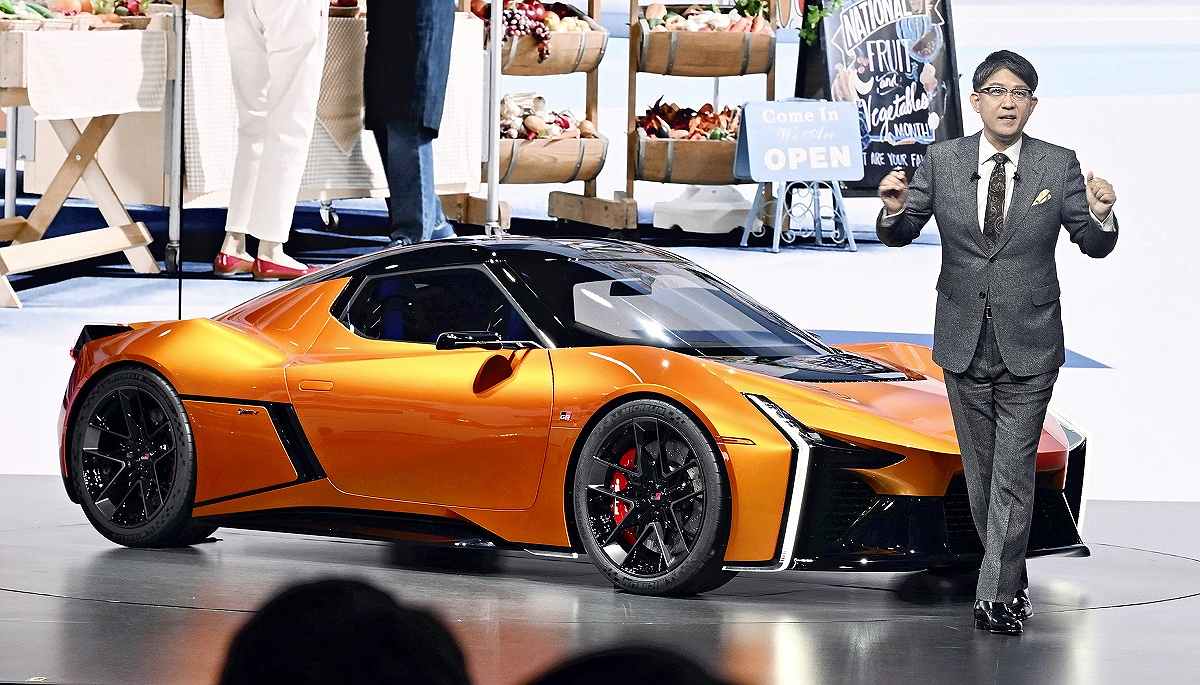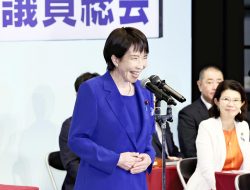
Toyota Motor Corporation President Koji Sato unveils the FT-Se EV at the Japan Mobility Show in Tokyo.
8:00 JST, November 11, 2023
Many analysts have noted that the Japanese auto industry, despite being highly competitive internationally, needs to catch up in the electric vehicle race. Will the Japanese auto industry, especially Toyota Motor Corporation, survive the competition? Let’s consider the question from the perspectives of three different factors.
The first perspective is the speed at which sales of electric vehicles, especially battery electric vehicles (BEVs), are increasing. After a period of faster-than-expected growth, BEV sales have recently slowed down in the United States, China and Europe. Major global companies such as Volkswagen and Ford Motor have revised their production plans downward.
The stock price of Tesla Inc., the world leader in electric cars, has plunged sharply. In contrast, Toyota has posted strong financial results, and the market reassessed its stock price thanks to solid sales of hybrid vehicles.
It may be helpful to think along the lines of the innovation theory proposed by sociologist Everett Rogers in his groundbreaking 1962 book “Diffusion of Innovations.” His theory sorts people into five categories based on how quickly or readily they take up new products and services. The first and smallest group are the “innovators,” at about 2.5% of the population, followed by “early adopters” (13.5%), the “early majority” (34%), the “late majority” (34%) and finally the “laggards” (16%).
According to the automotive industry research firm MarkLines, in 2022, electric vehicles (specifically BEVs) accounted for about 19% of new vehicle sales in China, about 11% in Europe, and about 6% in the United States. In Japan, it was only a little over 1%.
Europe, where EVs are relatively widespread, is thus in the early adopter stage, with the United States somewhat behind. China, where EVs are becoming even more widespread, is shifting from the early adopter stage to the early majority stage.
Early adopters are sensitive to trends, always keep their antennae up to gather information and make decisions, and love new products. In contrast, the early majority is relatively information-sensitive but is also cautious about adopting new products and services.
Automakers need to take their products to another level of innovation to bring EVs to the early majority soon. New levels of innovation include more advanced self-driving functions and entertainment options. It is also necessary to lower prices to make it easier for low- and middle-income consumers to afford the vehicles. All-solid-state batteries, which significantly increase a vehicle’s range, could be a game changer.
Technological innovation and investment decisions during this phase will largely determine future growth.
Many pundits have argued that Toyota is too cautious about introducing EVs. Now, Toyota is accelerating its EV strategy in the expectation that EV sales will eventually surge again after overcoming the recent stagnation.
As the world’s largest automaker, Toyota makes and sells around 10 million vehicles annually worldwide, and it plans to build a system capable of producing 1.5 million EVs by 2026. At a time when EV sales have slowed, Toyota’s announcement on Oct. 31 that it will invest an additional $8 billion in a battery plant in the United States is another notable move.
The problem is that batteries, a key component of electric vehicles, are subject to rapid technological innovation and can quickly become obsolete and a stranded asset.
Auto companies must make investment decisions at the right time. As EV adoption slows, the timing and type of investment will be critical in determining future competition.
The second of the three perspectives is the search for optimal solutions to promote decarbonization.
More is required than simply replacing internal combustion gasoline vehicles with EVs.
EVs do not emit CO2 while on the road. But considering the manufacturing process and electricity consumption, EVs are not emissions-free.
According to Toyota, looking at the energy mix by region as of 2020, thermal power generation, which emits CO2, accounted for 38% of the energy mix in Europe, even though renewable energy is widespread there. In Japan, thermal power’s share was 72%; in North America, 56%; in China, 67%; and worldwide, 65%.
Based on this power source composition and making certain assumptions about the manufacturing process and other considerations, the CO2 emissions of EVs would be 28 tons per vehicle over 10 years, lower than the 34 tons of gasoline cars. Hybrid vehicles, on the other hand, emit the same 28 tons as electric vehicles, with plug-in hybrids emitting the least at 24.5 tons.
While the power generation sector progresses in decarbonizing, further decarbonization of the power generation sector is essential. The energy sector revolution will substantially reduce the CO2 emissions of EVs.
Decarbonization efforts also face obstacles while energy supplies are constrained by Russia’s invasion of Ukraine, and energy prices are rising. The energy crisis will also affect the first point, the speed of EV adoption.
Regarding decarbonization, we need to look not only at the near term but also as far ahead as around 2050.
At that time, hydrogen technology will be a crucial factor in the power generation sector to realize a decarbonized society.
Once the hydrogen era is in full swing, EVs will play a more effective role in decarbonization. Fuel cell electrified vehicles that use hydrogen could become widespread, especially in commercial vehicles. Hydrogen combustion engine vehicles will also be an option.
Technological progress will not be monolithic. What will emerge as the predominant technology may be determined by a complex process of unpredictable improvements. Toyota is promoting the development of various technologies under its “multi-pathway” strategy. In an interview with The Yomiuri Shimbun, Toyota President Koji Sato said that the multi-pathway strategy is a realistic option that emphasizes providing the best mix of solutions tailored to customer characteristics in each region and ensures energy security. The transition process needs to be realistic and acceptable to consumers.
The third perspective is that of economic and energy security.
In the major industrialized countries of Japan, the United States and Europe, the auto industry employs large numbers of people and is deeply tied to the politics of each country.
Chinese automakers are leading the way in EVs, but if exports to the United States and Europe increase notably, political friction will be inevitable.
The United States has effectively shut out Chinese EVs through the Inflation Reduction Act. Considering the U.S.-China conflict, the United States will continue to prevent Chinese cars from entering the market through various regulations.
Europe, which is aiming for automotive supremacy with EVs, is also facing an export offensive of Chinese vehicles, and tensions are rising as investigations begin to determine whether Chinese manufacturers are receiving unfair subsidies.
Japan’s auto industry held the Japan Mobility Show in Tokyo from Oct. 28 to Nov. 5, and China’s BYD, the world’s second-largest seller of EVs, exhibited there for the first time as the company plans to launch a sales offensive in Japan. However, I think it remains uncertain whether the company’s strategy will be successful, because Japanese users have strong faith in domestic products.
If political friction increases, the major markets of the United States, Europe, Japan and China may become increasingly divided on economic and energy security.
As this trend deepens, it will become more difficult for advanced economy automakers to adopt cost-competitive Chinese battery materials. Therefore, the price of EVs will not decline, which brings us back to concerns about the first perspective: a slowdown in the speed of EV adoption.
In the long run, the transition to EVs will proceed.
However, the current competitive environment for EVs has entered an uncertain phase, and a deep fog is beginning to shroud it. These three factors interact to determine the speed at which EVs will spread, but the complexity is growing. Even Toyota risks slipping from the top of the automotive industry if it takes even a single wrong step, even for a moment.
Political Pulse appears every Saturday.

Akihiro Okada
Akihiro Okada is an editorial writer for The Yomiuri Shimbun.
"Editorial & Columns" POPULAR ARTICLE
-

Violations of Subcontract Law: Major Automakers Must Eliminate Old Practices
-

Local Governments’ Tax Revenues: Devise Ways to Correct Imbalances in Tax Sources
-

5 Japanese Business Dinner Mistakes to Avoid — and What They Taught Me About Business in Japan
-

Heavy Rains in Asia: Support for Victims, Flood-Control Measures Urgently Needed
-

Rice Coupons: A Misguided Approach to Countering Rising Prices
JN ACCESS RANKING
-

Keidanren Chairman Yoshinobu Tsutsui Visits Kashiwazaki-Kariwa Nuclear Power Plant; Inspects New Emergency Safety System
-

Imports of Rare Earths from China Facing Delays, May Be Caused by Deterioration of Japan-China Relations
-

University of Tokyo Professor Discusses Japanese Economic Security in Interview Ahead of Forum
-

Japan Pulls out of Vietnam Nuclear Project, Complicating Hanoi’s Power Plans
-

Govt Aims to Expand NISA Program Lineup, Abolish Age Restriction
























